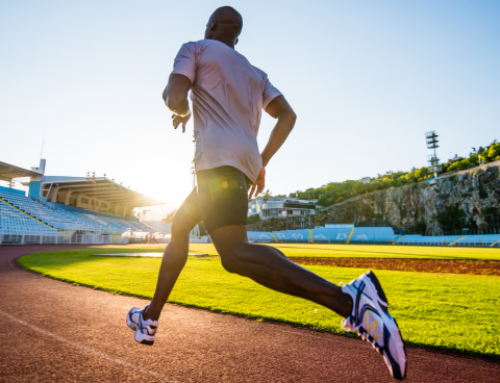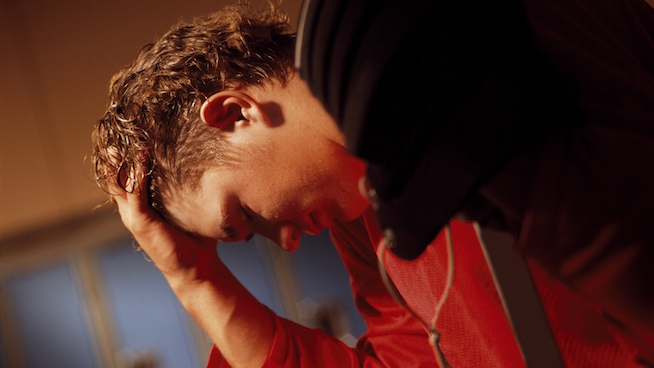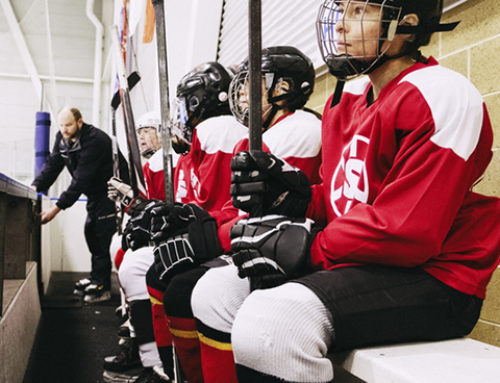Understanding the Benefits and Risks of Altitude Training
Altitude training refers to exposing the body to hypoxic environments (those which limit the amount of oxygen reaching the tissues) long enough to elicit physiological adaptations. These adaptations enhance the body’s ability to use oxygen and increase the athlete’s aerobic capacity. The result is an athlete who can move for extended periods of time at a slightly higher pace and recover more quickly between bouts of exercise.
The effects are caused mainly by the production of more red blood cells (RBC), which carry oxygen through the body. There are other contributing factors, but I’ll stick to the increased RBC mass, since it’s probably the most significant.
There also seems to be a dose-dependent response, or maybe even a threshold of sorts for these adaptations. Studies commonly cite 7,000 feet above sea level as the necessary “dose” of altitude to get the desired effects. Also, the process takes about two to three weeks to deliver maximum benefits. The effects are not permanent, as RBC mass returns to normal about 15 days after the athlete drops below the aforementioned altitude.
RELATED: Improve Your Performance By Training at the Perfect Altitude
Athletes Who May Benefit
At first glance, it may seem like only distance runners and endurance athletes would benefit from altitude training. Although these athletes benefit significantly, almost all athletes stand to reap some gains from this training. Even if the physiological adaptations don’t directly carry over to their performance at sea level, athletes who compete at high altitudes from time to time should strongly consider acclimating before competition.
For this reason, training camps throughout Colorado are destinations for thousands of athletes every year. But is it necessary to fly across the country to reap these benefits? Maybe not.
Up-to-Date Recommendations
Previously, many athletes have trained at higher altitudes, hoping to increase their ability to use oxygen. They did so at the cost of lower performance stimuli during training. The athletes adapted but also hindered their ability to perform by exposing themselves to hypoxia, which prevented them from training as hard as they could at sea level. Therefore, their performance measurements did not always correlate, leading to mixed results at best. At worst, much of the increase in performance may have resulted from instruction at these camps more than exposure to higher altitude.
RELATED: Run Faster and Lift Better by Learning How to Breathe
Live High, Train Low
Exercise scientists were challenged to create the positive effects of higher altitude within an environment of normal oxygen concentration (normoxic). For endurance runners, this could be as simple as supplying oxygen while training at altitude. For dynamic athletes, it might require a more elaborate approach, such as sleeping in hypoxic tents while living and training at sea level. Either way, the concept of “Live High, Train Low” was born.
This model exposes the athlete to a hypoxic environment for a number of hours per day, typically accomplished by sleeping in an altitude tent. The athlete trains normally and does not have to relocate or travel to gain either the high altitude exposure or low normoxic training. This simulated “living high” (2,500–3,000 meters above sea level) for eight to 10 hours a day and “training low” (below 1,200 meters above sea level) for 18 days has shown significant improvements, which may last as long as 15 days after exposure. A recent study shows an increase in RBC mass in as few as 10 days, but the length of time and extent of adaptation is highly individualized. Furthermore, repeated sprints in hypoxia have elicited greater training adaptations than repeated sprints at normoxia, but the gains seem to be more anaerobic in nature and may have been further improved with the Live High, Train Low scenario.
This technique has been so effective, more elaborate strategies are presented every year, with researchers constantly refining Live High, Train Low to find the optimum combination of training stimuli and altitude exposure. Some have even proposed increasing oxygen beyond the norm, hoping to further increase training stimulus. With small differences determining winners at the highest levels, these strategies may become standard practice for elite endurance and triathlon competitors. Coaches of other sports may be well advised to look into altitude training strategies as they become more convenient and practical, as has been seen with the altitude-simulating tents.
RELATED: The Brian Urlacher Workout
Drawbacks
Altitude exposure is not without its share of issues.
During altitude training, athletes may experience decreased REM sleep. The hypoxic environment can hinder breathing for some, and significantly affect sleep, which could potentially decrease the athlete’s rate of recovery. The reward seems to outweigh this particular drawback, as multiple studies confirm the positive adaptations of altitude exposure. Nevertheless, this should be considered by coaches.
Exposure to high altitudes reduces the athlete’s ability to recover between sets of anaerobic and fatiguing exercise. This may be due to a number of peripheral or central factors, but no matter the cause, the result is a gradual decline in the athlete’s ability to perform an otherwise normal practice. This accelerated fatigue could lead to decreased psychological awareness during training, fewer repetitions (slowing the rate of skill acquisition or refinement) and potential overall de-conditioning, all of which support the idea of seeking normoxic training environments.
It is crucial to understand that not all athletes respond to altitude exposure the same way. Almost all of the studies note individual differences throughout the experimental groups.
Monitoring an athlete’s heart rate, sleep, mood and training performance can prevent altitude training from causing more harm than good. It’s also important to hydrate properly and increase one’s carbohydrate intake, since the lack of oxygen saturation often increases reliance on anaerobic energy. Antioxidant supplementation is also an option, since exposure to high altitudes increases oxidative stress, especially when combined with exercise.
RELATED: Ellery Hollingsworth’s High-Altitude Gatorade Hydration Plan
Training in Masks
Training masks, which supposedly mimic a hypoxic environment (by reducing available oxygen), are marketed using similar research from hypoxic environments to back them up. Considering the hindered performance capability of the athlete during oxygen restriction, I’m of the opinion these masks offer little to no benefit. The only reason I would have an athlete train in a mask that restricts oxygen is to become familiar with the mask—not for physical training purposes. Emergency responses or simulations by firefighters or soldiers are the only times I actually backed the idea of wearing that type of gear. Otherwise, the athlete may hinder his or her training more than improve it, due the accelerated rate of fatigue.
References:
Faiss R, Girard O, & Millet GP. (2013). “Advancing hypoxic training in team sports: from intermittent hypoxic training to repeated sprint training in hypoxia.” Br J Sports Med, 47 Suppl 1:i45-50. doi: 10.1136/bjsports-2013-092741.
Rodríguez, FA, Truijens, MJ, Townsend, NE, Stray-Gundersen, J et al. (2007). “Performance of runners and swimmers after four weeks of intermittent hypobaric hypoxic exposure plus sea level training.” Journal of Applied Physiology (Am Physiological Soc) 103 (5): 1523–1535. doi:10.1152/japplphysiol.01320.2006. PMID 17690191.
Brugniaux, JV, Schmitt, L, Robach, P, Nicolet, G et al. (January 2006). “Eighteen days of “living high, training low” stimulate erythropoiesis and enhance aerobic performance in elite middle-distance runners.” Journal of Applied Physiology 100 (1): 203–11. doi:10.1152/japplphysiol.00808.2005. PMID 16179396. Retrieved 2009-01-05.
Bakonyi T & Radak Z. (2004). “High Altitude and Free Radicals.” J Sports Sci Med, 3(2):64-69. eCollection 2004.
Dosek A, Ohno H, Acs Z, Taylor AW & Radak Z. (2007). “High altitude and oxidative stress.” Respir Physiol Neurobiol, 158(2-3):128-31. Epub 2007 Mar 31.
Sargent C, Schmidt WF, Aughey RJ, Bourdon PC, Soria R, Claros JC, Garvican-Lewis LA, Buchheit M, Simpson BM, Hammond K, Kley M, Wachsmuth N, Gore CJ, & Roach GD. (2013). “The impact of altitude on the sleep of young elite soccer players (ISA3600).” Br J Sports Med, 47 Suppl 1:i86-92. doi: 10.1136/bjsports-2013-092829.
Roach GD1, Schmidt WF, Aughey RJ, Bourdon PC, Soria R, Claros JC, Garvican-Lewis LA, Buchheit M, Simpson BM, Hammond K, Kley M, Wachsmuth N, Gore CJ, & Sargent C. (2013). “The sleep of elite athletes at sea level and high altitude: a comparison of sea-level natives and high-altitude natives (ISA3600).” Br J Sports Med, 47 Suppl 1:i114-20. doi: 10.1136/bjsports-2013-092843.
Billaut F, Kerris J, Rodriguez R, et al. (2013). “Interaction of central and peripheral factors during repeated sprints at different levels of arterial O2 saturation.” PLoS ONE, in press. doi:10.1371/journal.pone.0077297
Garvican-Lewis LA1, Clark SA, Polglaze T, McFadden G, & Gore CJ. (2013). “Ten days of simulated live high:train low altitude training increases Hbmass in elite water polo players.” Br J Sports Med, 47 Suppl 1:i70-3. doi: 10.1136/bjsports-2013-092746.
Millet GP1, Roels B, Schmitt L, Woorons X, & Richalet JP. (2010). “Combining hypoxic methods for peak performance.” Sports Med, 40(1):1-25. doi: 10.2165/11317920-000000000-00000.
Bishop DJ & Girard O. (2013). “Determinants of team-sport performance: implications for altitude training by team-sport athletes.” Br J Sports Med, 47 Suppl 1:i17-21. doi: 10.1136/bjsports-2013-092950.
[cf]skyword_tracking_tag[/cf]RECOMMENDED FOR YOU
MOST POPULAR
Understanding the Benefits and Risks of Altitude Training
Altitude training refers to exposing the body to hypoxic environments (those which limit the amount of oxygen reaching the tissues) long enough to elicit physiological adaptations. These adaptations enhance the body’s ability to use oxygen and increase the athlete’s aerobic capacity. The result is an athlete who can move for extended periods of time at a slightly higher pace and recover more quickly between bouts of exercise.
The effects are caused mainly by the production of more red blood cells (RBC), which carry oxygen through the body. There are other contributing factors, but I’ll stick to the increased RBC mass, since it’s probably the most significant.
There also seems to be a dose-dependent response, or maybe even a threshold of sorts for these adaptations. Studies commonly cite 7,000 feet above sea level as the necessary “dose” of altitude to get the desired effects. Also, the process takes about two to three weeks to deliver maximum benefits. The effects are not permanent, as RBC mass returns to normal about 15 days after the athlete drops below the aforementioned altitude.
RELATED: Improve Your Performance By Training at the Perfect Altitude
Athletes Who May Benefit
At first glance, it may seem like only distance runners and endurance athletes would benefit from altitude training. Although these athletes benefit significantly, almost all athletes stand to reap some gains from this training. Even if the physiological adaptations don’t directly carry over to their performance at sea level, athletes who compete at high altitudes from time to time should strongly consider acclimating before competition.
For this reason, training camps throughout Colorado are destinations for thousands of athletes every year. But is it necessary to fly across the country to reap these benefits? Maybe not.
Up-to-Date Recommendations
Previously, many athletes have trained at higher altitudes, hoping to increase their ability to use oxygen. They did so at the cost of lower performance stimuli during training. The athletes adapted but also hindered their ability to perform by exposing themselves to hypoxia, which prevented them from training as hard as they could at sea level. Therefore, their performance measurements did not always correlate, leading to mixed results at best. At worst, much of the increase in performance may have resulted from instruction at these camps more than exposure to higher altitude.
RELATED: Run Faster and Lift Better by Learning How to Breathe
Live High, Train Low
Exercise scientists were challenged to create the positive effects of higher altitude within an environment of normal oxygen concentration (normoxic). For endurance runners, this could be as simple as supplying oxygen while training at altitude. For dynamic athletes, it might require a more elaborate approach, such as sleeping in hypoxic tents while living and training at sea level. Either way, the concept of “Live High, Train Low” was born.
This model exposes the athlete to a hypoxic environment for a number of hours per day, typically accomplished by sleeping in an altitude tent. The athlete trains normally and does not have to relocate or travel to gain either the high altitude exposure or low normoxic training. This simulated “living high” (2,500–3,000 meters above sea level) for eight to 10 hours a day and “training low” (below 1,200 meters above sea level) for 18 days has shown significant improvements, which may last as long as 15 days after exposure. A recent study shows an increase in RBC mass in as few as 10 days, but the length of time and extent of adaptation is highly individualized. Furthermore, repeated sprints in hypoxia have elicited greater training adaptations than repeated sprints at normoxia, but the gains seem to be more anaerobic in nature and may have been further improved with the Live High, Train Low scenario.
This technique has been so effective, more elaborate strategies are presented every year, with researchers constantly refining Live High, Train Low to find the optimum combination of training stimuli and altitude exposure. Some have even proposed increasing oxygen beyond the norm, hoping to further increase training stimulus. With small differences determining winners at the highest levels, these strategies may become standard practice for elite endurance and triathlon competitors. Coaches of other sports may be well advised to look into altitude training strategies as they become more convenient and practical, as has been seen with the altitude-simulating tents.
RELATED: The Brian Urlacher Workout
Drawbacks
Altitude exposure is not without its share of issues.
During altitude training, athletes may experience decreased REM sleep. The hypoxic environment can hinder breathing for some, and significantly affect sleep, which could potentially decrease the athlete’s rate of recovery. The reward seems to outweigh this particular drawback, as multiple studies confirm the positive adaptations of altitude exposure. Nevertheless, this should be considered by coaches.
Exposure to high altitudes reduces the athlete’s ability to recover between sets of anaerobic and fatiguing exercise. This may be due to a number of peripheral or central factors, but no matter the cause, the result is a gradual decline in the athlete’s ability to perform an otherwise normal practice. This accelerated fatigue could lead to decreased psychological awareness during training, fewer repetitions (slowing the rate of skill acquisition or refinement) and potential overall de-conditioning, all of which support the idea of seeking normoxic training environments.
It is crucial to understand that not all athletes respond to altitude exposure the same way. Almost all of the studies note individual differences throughout the experimental groups.
Monitoring an athlete’s heart rate, sleep, mood and training performance can prevent altitude training from causing more harm than good. It’s also important to hydrate properly and increase one’s carbohydrate intake, since the lack of oxygen saturation often increases reliance on anaerobic energy. Antioxidant supplementation is also an option, since exposure to high altitudes increases oxidative stress, especially when combined with exercise.
RELATED: Ellery Hollingsworth’s High-Altitude Gatorade Hydration Plan
Training in Masks
Training masks, which supposedly mimic a hypoxic environment (by reducing available oxygen), are marketed using similar research from hypoxic environments to back them up. Considering the hindered performance capability of the athlete during oxygen restriction, I’m of the opinion these masks offer little to no benefit. The only reason I would have an athlete train in a mask that restricts oxygen is to become familiar with the mask—not for physical training purposes. Emergency responses or simulations by firefighters or soldiers are the only times I actually backed the idea of wearing that type of gear. Otherwise, the athlete may hinder his or her training more than improve it, due the accelerated rate of fatigue.
References:
Faiss R, Girard O, & Millet GP. (2013). “Advancing hypoxic training in team sports: from intermittent hypoxic training to repeated sprint training in hypoxia.” Br J Sports Med, 47 Suppl 1:i45-50. doi: 10.1136/bjsports-2013-092741.
Rodríguez, FA, Truijens, MJ, Townsend, NE, Stray-Gundersen, J et al. (2007). “Performance of runners and swimmers after four weeks of intermittent hypobaric hypoxic exposure plus sea level training.” Journal of Applied Physiology (Am Physiological Soc) 103 (5): 1523–1535. doi:10.1152/japplphysiol.01320.2006. PMID 17690191.
Brugniaux, JV, Schmitt, L, Robach, P, Nicolet, G et al. (January 2006). “Eighteen days of “living high, training low” stimulate erythropoiesis and enhance aerobic performance in elite middle-distance runners.” Journal of Applied Physiology 100 (1): 203–11. doi:10.1152/japplphysiol.00808.2005. PMID 16179396. Retrieved 2009-01-05.
Bakonyi T & Radak Z. (2004). “High Altitude and Free Radicals.” J Sports Sci Med, 3(2):64-69. eCollection 2004.
Dosek A, Ohno H, Acs Z, Taylor AW & Radak Z. (2007). “High altitude and oxidative stress.” Respir Physiol Neurobiol, 158(2-3):128-31. Epub 2007 Mar 31.
Sargent C, Schmidt WF, Aughey RJ, Bourdon PC, Soria R, Claros JC, Garvican-Lewis LA, Buchheit M, Simpson BM, Hammond K, Kley M, Wachsmuth N, Gore CJ, & Roach GD. (2013). “The impact of altitude on the sleep of young elite soccer players (ISA3600).” Br J Sports Med, 47 Suppl 1:i86-92. doi: 10.1136/bjsports-2013-092829.
Roach GD1, Schmidt WF, Aughey RJ, Bourdon PC, Soria R, Claros JC, Garvican-Lewis LA, Buchheit M, Simpson BM, Hammond K, Kley M, Wachsmuth N, Gore CJ, & Sargent C. (2013). “The sleep of elite athletes at sea level and high altitude: a comparison of sea-level natives and high-altitude natives (ISA3600).” Br J Sports Med, 47 Suppl 1:i114-20. doi: 10.1136/bjsports-2013-092843.
Billaut F, Kerris J, Rodriguez R, et al. (2013). “Interaction of central and peripheral factors during repeated sprints at different levels of arterial O2 saturation.” PLoS ONE, in press. doi:10.1371/journal.pone.0077297
Garvican-Lewis LA1, Clark SA, Polglaze T, McFadden G, & Gore CJ. (2013). “Ten days of simulated live high:train low altitude training increases Hbmass in elite water polo players.” Br J Sports Med, 47 Suppl 1:i70-3. doi: 10.1136/bjsports-2013-092746.
Millet GP1, Roels B, Schmitt L, Woorons X, & Richalet JP. (2010). “Combining hypoxic methods for peak performance.” Sports Med, 40(1):1-25. doi: 10.2165/11317920-000000000-00000.
Bishop DJ & Girard O. (2013). “Determinants of team-sport performance: implications for altitude training by team-sport athletes.” Br J Sports Med, 47 Suppl 1:i17-21. doi: 10.1136/bjsports-2013-092950.
[cf]skyword_tracking_tag[/cf]










